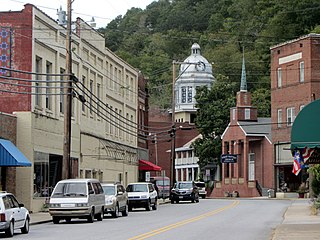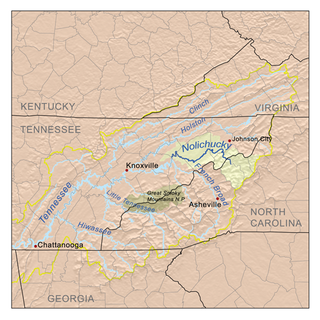Related Research Articles

Marshall is a town in Madison County, North Carolina, United States. The population was 872 at the 2010 census. It is the county seat of Madison County.

Cold Mountain is a 2003 epic period war drama film written and directed by Anthony Minghella. The film is based on the bestselling 1997 novel by Charles Frazier. It stars Jude Law, Nicole Kidman, and Renée Zellweger with Eileen Atkins, Brendan Gleeson, Kathy Baker, Philip Seymour Hoffman, Natalie Portman, Jack White, Giovanni Ribisi, Donald Sutherland, and Ray Winstone in supporting roles. The film tells the story of a wounded deserter from the Confederate army close to the end of the American Civil War, who journeys home to reunite with the woman he loves. The film was a co-production of companies in Italy, Romania, and the United States.

Augustus Summerfield Merrimon was a Democratic U.S. senator from the state of North Carolina between 1873 and 1879.
Charles Frazier is an American novelist. He won the 1997 National Book Award for Fiction for Cold Mountain.

The Battle of Cedar Creek, or Battle of Belle Grove, was fought on October 19, 1864, during the American Civil War. The fighting took place in the Shenandoah Valley of Northern Virginia, near Cedar Creek, Middletown, and the Valley Pike. During the morning, Lieutenant General Jubal Early appeared to have a victory for his Confederate army, as he captured over 1,000 prisoners and over 20 artillery pieces while forcing seven enemy infantry divisions to fall back. The Union army, led by Major General Philip Sheridan, rallied in late afternoon and drove away Early's men. In addition to recapturing all of their own artillery seized in the morning, Sheridan's forces captured most of Early's artillery and wagons.

The Battle of Fort Pillow, also known as the Fort Pillow Massacre, was fought on April 12, 1864, at Fort Pillow on the Mississippi River in Henning, Tennessee, during the American Civil War. The battle ended with Confederate soldiers commanded by Major General Nathan Bedford Forrest massacring Union soldiers attempting to surrender. Military historian David J. Eicher concluded: "Fort Pillow marked one of the bleakest, saddest events of American military history."

The Second Battle of Fort Wagner, also known as the Second Assault on Morris Island or the Battle of Fort Wagner, Morris Island, was fought on July 18, 1863, during the American Civil War. Union Army troops commanded by Brig. Gen. Quincy Gillmore launched an unsuccessful assault on the Confederate fortress of Fort Wagner, which protected Morris Island, south of Charleston Harbor. The battle occurred one week after the First Battle of Fort Wagner. Although it was a Confederate victory, the valor of the Black Union soldiers was widely praised. This had long-term strategic benefits by encouraging more African-Americans to enlist, allowing the Union to utilize a manpower resource that the Confederacy could not match for the remainder of the war.
The Battle of Poison Spring, also known as the Poison Spring massacre, was fought in Ouachita County, Arkansas, on April 18, 1864, as part of the Camden Expedition, during the American Civil War. A Union force commanded by Major General Frederick Steele had moved from Little Rock, Arkansas, in support of Major General Nathaniel Banks's movement along the Red River towards Shreveport, Louisiana. Steele's objective was also Shreveport, and his men occupied Camden, Arkansas. After Banks was defeated at the battles of Mansfield and Pleasant Hill, Steele was isolated in Arkansas. Short on supplies, Steele sent a detachment commanded by Colonel James M. Williams on April 17 to forage for 5,000 bushels of corn that were reported to be in the area.
The 14th Connecticut Infantry Regiment, also known as the Nutmeg Regiment, was an infantry regiment that participated in the American Civil War. It participated in the Battle of Gettysburg, helping to repulse the Confederate attack on the third day known as Pickett's Charge.

Sarah Malinda Pritchard Blalock was a female soldier during the American Civil War. Despite originally being a sympathizer for the right of secession, she fought on both sides. She followed her husband, William Blalock, and joined the CSA's 26th North Carolina Regiment, disguising herself as a young man and calling herself Samuel Blalock. The couple eventually escaped by crossing Confederate lines and joining the Union partisans in the mountains of western North Carolina. During the last years of the war, she was a pro-Union marauder raiding the Appalachia region. Today she is one of the most remembered female combatants of the Civil War.

Cold Mountain is a 1997 historical novel by Charles Frazier which won the U.S. National Book Award for Fiction. It tells the story of W. P. Inman, a wounded deserter from the Confederate army near the end of the American Civil War who walks for months to return to Ada Monroe, the love of his life; the story shares several similarities with Homer's Odyssey, with the protagonist's circuitous and often derailed journey homeward as the central example. Nearly every chapter alternates between the stories of Inman and Ada, a minister's daughter recently relocated from Charleston to a farm in a rural mountain community near Cold Mountain, North Carolina, from which Inman hails. Though they knew each other only for a brief time before Inman departed for the war, it is largely the hope of seeing Ada again that drives Inman to desert the army and make the dangerous journey back to Cold Mountain. Details of their brief history together are told at intervals in flashback over the course of the novel.
The Centralia Massacre was an incident during the American Civil War in which 24 unarmed U.S. Army soldiers were captured and executed in Centralia, Missouri, on September 27, 1864, by a band of men under the command of the notorious Confederate guerrilla leader "Bloody Bill" Anderson. Future outlaw Jesse James was among the guerrillas.

William Holland Thomas was an American merchant, lawyer, politician and soldier.
The 2nd West Virginia Cavalry Regiment served in the Union Army during the American Civil War. It was organized in Parkersburg, Virginia during September 1861. Most of the original members of this regiment were from southeastern Ohio, and planners thought that this regiment would become the 4th Ohio Cavalry. Their application was rejected by the governor of Ohio, so the unit became the 2nd Regiment of Loyal Virginia Volunteer Cavalry. The "Loyal Virginia" part of the name was replaced with "West Virginia" after the state of West Virginia was officially admitted to the Union in 1863. Today, the National Park Service lists them as 2nd Regiment, West Virginia Cavalry under a heading of Union West Virginia Volunteers.

The Home Guard of the several states of the Confederacy during the American Civil War included all able-bodied white males between the ages of 18 and 50 who were exempt from Confederate service, excepting only the governor and other officials. The Home Guard replaced the militia whose members had volunteered or been conscripted into service in the Confederate Army.
The 3rd North Carolina (Volunteer) Mounted Infantry was an all-volunteer mounted infantry regiment that served in the Union Army during the American Civil War. The regiment was predominantly composed of Union Loyalists from North Carolina, but also included volunteers from Tennessee and several other states.
The Battle of Columbus, Georgia, was the last conflict in the Union campaign through Alabama and Georgia, known as Wilson's Raid, in the final full month of the American Civil War.

The 4th North Carolina Infantry Regiment was a Confederate States Army regiment during the American Civil War, active from 1861 until the war's end in April 1865. Ordered to Virginia, the unit served in General Winfield S. Featherston’s, George B. Anderson’s, Stephen D. Ramseur’s, and William R. Cox’s Brigade. Its field officers were Colonels George B. Anderson, Bryan Grimes, Edwin A. Osborne, and James H. Wood; Lieutenant Colonels David M. Carter and John A. Young; and Majors Edward S. Marsh and Absalom K. Simonton. It was nicknamed "The Bloody Fourth" after the high rate of casualties at the Battle of Seven Pines.

The Battle of Red Banks was an American Civil War battle that took place on December 29, 1864, between Union and Confederate forces. It took place at the Red Banks of the Nolichucky River in Unicoi County, Tennessee near the North Carolina border. Southern soldiers referred to the conflict as the Battle of the Bloody Chucky.

The Battle of Fayetteville occurred in Fayette County, Virginia, on September 10, 1862, during the American Civil War. A Confederate Army, consisting of multiple brigades commanded by Major General William W. Loring, drove away a Union brigade commanded by Colonel Edward Siber. The battle is part of the Kanawha Valley Campaign of 1862.
References
- 1 2 3 4 5 6 Manly Wellman, The Kingdom of Madison (Chapel Hill, N.C.: University of North Carolina Press, 1973), pp. 83-84.
- 1 2 3 4 5 6 Gerard, Phillip (29 April 2012). "Atrocity at Shelton Laurel". www.ourstate.com. Mann media. Retrieved 2 August 2014.
- ↑ William Trotter, Bushwhackers! The Mountains (John F. Blair Publishers, 1991), pp. 224-232.
- 1 2 Paludan, Philip S. 1981. Victims: A True Story of the Civil War. Knoxville, TN: The University of Tennessee Press. p. 144.
- ↑ North Carolina Highway History Marker Program: Madison County, Marker P-71
- ↑ North Carolina Visions: Season 12 Featured Films. Archived 2012-09-19 at archive.today
- ↑ Southern Writers: The World Made Straight. Archived 2008-08-08 at the Wayback Machine
- ↑ "The World Made Straight (2015)". IMDb. Retrieved 2019-01-19.
- ↑ Holt, Karen (2005). "Frazier's Cold Mountain". The Explicator. Retrieved 2 August 2014.